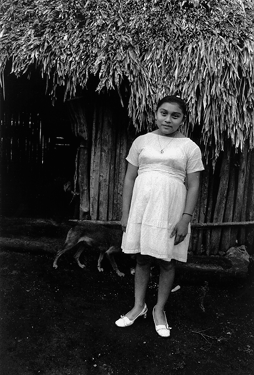The Modern Maya |
||
| Overview
Yucatán is the only major peninsula in the world (outside of Antarctica) which juts up rather than down. If Italy is shaped like a boot, then Yucatán resembles a thumb sticking into and separating the Gulf of Mexico and the Caribbean Sea. It is a monotonously flat limestone plateau, although a small ridge tries to cross it diagonally but soon runs out of height. The land is rocky, offers very little soil to grow crops, and has few lakes, streams, or rivers. A thorny scrub forest covers the land, gradually becoming a jungle to the southeast. The Maya in the Yucatán prospered in this environment and their cities reached their zenith between 800 - 1000 A.D. Although the Maya abandoned some sites, they were still living in their cities and practicing their religion when the Spanish arrived. In 1562, Fray Diego de Landa destroyed 5,000 idols and burned twenty-seven hieroglyphic rolls at the auto-da-fŽ of Mani. "We found a large number of books," he wrote, "in these characters (Maya writing) and as they contained nothing in which there were not to be seen superstition and lies of the devil, we burned them all, which they regretted to an amazing degree, and which caused them much affliction." The gathered Maya watched two thousand years of their collected culture burn. Landa, who later became bishop of Yucatán, claimed that Spain brought to the Maya "justice and Christianity, and the peace in which they live." However, the Spanish brought diseases which the American Indians had no resistance to; the first epidemics killed from one-third to one-half of the Indians in Mesoamerica. They died from cholera, malaria, measles, plague, syphilis, smallpox, tuberculosis, typhoid, and typhus. They died at the hands of the Spanish soldiers, from religious persecution, and from overwork as slaves. By the end of the first one hundred years of Spanish rule in Mexico, the Indian population had been reduced by as much as 90 percent. Mention the Maya to most people and they conjure up an image of ancient ruins and lost civilizations. And truly the Maya created the greatest civilization in the Americas, constructing elaborate cities and producing a written language and calendar that are remarkable even by today's standards. But few people realize the Maya race is not an archaeological relic. More than two million Maya are living today, direct descendants of their pyramid-building ancestors. The modern Maya live in the highlands of Guatemala and Southern Mexico, and the lowlands of the Yucatán peninsula. Not only geography, but also cultural differences distinguish the Maya inhabitants of each region. |
|
Monte Cristo, 1971 |
The Modern Maya is about the lowland Maya -- the Maya of Yucatán. These are the faces of the modern Maya, and something of the ancient Maya culture has survived in their contemporary lives -- their gods, their cuisine, their ceremonies, their agricultural methods, their humor, their beliefs, their medicine, and above all their respect for the forest in which they live. Botanists are now pointing out that not only is it important to save tropical rain forests for their biological diversity, it is also important to include the local cultures for their knowledge of the forests. Twenty years with the Maya has made me realize cultures other than our own need to be considered not merely as curiosities and anachronisms, but for the unwritten knowledge they have to offer. We are seeing the growth of an industrialized and computerized world culture that increasingly erases the differences among cultures. However, any species is at risk if it becomes too specialized. What ultimately happens to the Maya, and to other non-European cultures, may affect us all. |
||
Milperos
and Maize - The Foundation of a Culture |
The Modern Maya - book information
|
|
